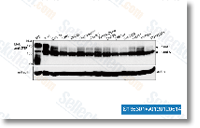GAPDH and HADHA were also downregulated on the IMMO time level and 40% for HADHA but returned practically back to base line expression in the REHAB time point. Despite manifest ing a time impact, S26 was not appreciably downregulated at either time stage. Protein expression and phosphorylation Regardless of the evident modifications in muscle mass, we observed no sizeable modulation of complete or phospho protein levels of Akt, GSK3B, 4EBP1, ubiquitin or MURF1 in Examine one. Total and phosphory lated amounts of mTOR and S6k were under the detection threshold. Review 2 Muscle power and size In Study 2, we report further muscle power and size information to the REHAB time points. For power, no significant time effects have been detected in either leg.
Following two and 6 weeks of rehabilitation, strength was elevated to ranges somewhat higher than individuals recorded ahead of immobilization, but these distinctions didn’t reach significance. For muscle size, no differ ences had been observed amongst the REHAB time level and PRE. mRNA expression For mRNA, we observed time effects selleck chemical STAT inhibitor for FOXO1, Atrogin 1, GAPDH, HADHA and S26. Notably, for neither FOXO1 nor Atrogin one, the main effect could possibly be observed as deviations selleckchem from PRE. For each GAPDH and HADHA, we observed a downregula tion on the IMMO time stage and 24% for HADHA and also a sub sequent return to baseline expression, whereas for S26 we found a downregulation with the IMMO time level that persisted throughout the REHAB time stage and 20% at REHAB. Protein expression and phosphorylation Contrary on the modifications in muscle mass reported previ ously, we identified no major modulation of complete or phosphoprotein levels of Akt, GSK3B, 4EBP1, ubiqui tin or MURF1 in Examine 2.
Total and phos phorylated ranges of mTOR and S6k have been under the detection threshold.  Discussion For Research one, we hypothesized that the two weeks immobilization would reduce Akt and mTOR signaling in conjunction with elevated FOXO3, Atrogin 1 and MURF1 mRNA expression, reflecting the loss of muscle mass previ ously reported for this examine. We observed no adjustments in Akt and mTOR signaling, and of FOXO3, Atrogin one and MURF1 only FOXO3 was substantially downregulated immediately after immobilization, and that is opposite of what we anticipated. Fur thermore, we hypothesized that the regular rehabilitation can be inadequate to recover signaling and mRNA ex pression relative to submit immobilization. As hypothesized, signaling and all mRNAs, except the downregulated FOXO3, have been unchanged with rehabilitation relative for the IMMO time point. For Review two, we hypothesized decreased Akt and mTOR signaling as well as elevated FOXO3, Atrogin one and MURF1 transcripts after immobilization. Unexpectedly, Akt and mTOR signaling and also the measured mRNAs remained unchanged after immobilization.
Discussion For Research one, we hypothesized that the two weeks immobilization would reduce Akt and mTOR signaling in conjunction with elevated FOXO3, Atrogin 1 and MURF1 mRNA expression, reflecting the loss of muscle mass previ ously reported for this examine. We observed no adjustments in Akt and mTOR signaling, and of FOXO3, Atrogin one and MURF1 only FOXO3 was substantially downregulated immediately after immobilization, and that is opposite of what we anticipated. Fur thermore, we hypothesized that the regular rehabilitation can be inadequate to recover signaling and mRNA ex pression relative to submit immobilization. As hypothesized, signaling and all mRNAs, except the downregulated FOXO3, have been unchanged with rehabilitation relative for the IMMO time point. For Review two, we hypothesized decreased Akt and mTOR signaling as well as elevated FOXO3, Atrogin one and MURF1 transcripts after immobilization. Unexpectedly, Akt and mTOR signaling and also the measured mRNAs remained unchanged after immobilization.
BRAF signal
The BRAF gene is a proto-oncogene
